Activated Carbon
What is Activated Carbon?
Activated carbon, also known as activated charcoal, activated coal, or active carbon, is a highly effective adsorbent. Its extensive surface area, varied pore structure (micro, meso, and macro), and high surface reactivity make it ideal for purifying, dechlorinating, deodorizing, and decolorizing in both liquid and vapour applications. Additionally, activated carbon is a cost-effective adsorbent used across various industries, including water purification, food processing, cosmetology, automotive, industrial gas purification, and petroleum and precious metal recovery, particularly gold. It is typically derived from coconut shells, coal, or wood.
Application of Activated carbon
Different types of activated carbon are tailored for specific applications.
- Granulated activated carbon
- Pelletized activated carbon
- Powdered activated carbon
- Impregnated activated carbon
- Catalytic activated carbon
Each grade and size of activated carbon is designed for a particular purpose. Choosing the appropriate product and mesh size depends on the specific application and the contaminants you aim to remove.
Common applications include:
- Eliminating volatile organic compounds like Benzene, TCE, and PCE
- Removing Hydrogen Sulfide (H₂S) and other waste gases
- Using impregnated activated carbon as a bacterial inhibitor in drinking water filters
- Removing taste and odor-causing compounds such as MIB and geosmin
- Recovering gold
- Eliminating chlorine and chloramine
Proper design of an activated carbon filtration system, with adequate contact time, pressure drop, and vessel size is crucial. The physical and chemical properties of activated carbon also significantly impact its effectiveness in contaminant removal. Therefore, material testing, including ASTM.
Activated carbon is regarded as the most effective absorbent globally. It is environmentally friendly because it can be regenerated and reused.
Types of activated carbon
Activated carbon derived from coconut shell
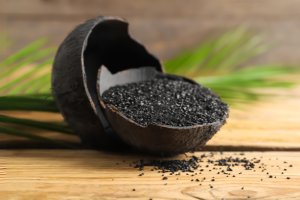
Coconut shell-based activated carbons are highly desirable for water treatment, critical air applications, point-of-use water filters, and respirators due to their:
- Extremely high surface area with a significant proportion of micropores
- High hardness and minimal dust production
- Superior purity, with ash content typically between 3-5%
- Use of renewable and eco-friendly raw materials
Activated Carbon Derived from Coal
This relatively low-cost filter media is in high demand for both gas and liquid applications. Coal-based activated carbon features a high surface area with both mesopores and micropores.
- Consistent density
- Durable materials with minimal dust production
- Cost-effective
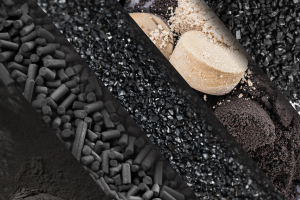
Activated Carbon Derived from Wood
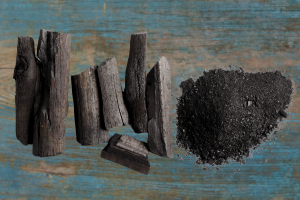
Wood-based activated carbon offers distinct performance characteristics compared to coal or coconut-based products are typically used in industrial applications.
It features a high surface area with a mix of mesopores and micropores, and its unique porosimetry provides excellent decolorizing properties.
- Relatively low density
- Sourced from renewable materials
Catalytic based activated carbon
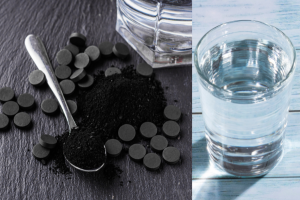
Catalytic carbon is a type of activated carbon designed for removing chloramines and hydrogen sulfide from drinking water.
In addition to the standard adsorptive properties of conventional activated carbons, catalytic carbon also facilitates chemical reactions.
Catalytic carbon does not contain caustic chemical impregnations.
Because catalytic carbons are not impregnated, you won’t experience issues like reduced organic odour capacity or increased risk of bed fires associated with impregnated carbons.
Catalytic carbon is produced by modifying the surface structure of activated carbon through high-temperature gas processing. This process alters the electronic structure, enhancing catalytic activity to effectively reduce chloramines and H₂S in water. Its catalytic functionality far surpasses that of traditional activated carbons. Catalytic carbon is a cost-effective solution for treating H₂S levels up to 20 to 30 ppm. It transforms adsorbed H₂S into sulfuric and sulfurous acids, which are water-soluble, allowing for the regeneration of the carbon with water washing and reducing the need for frequent physical change-outs.
Impregnated Activated Carbon
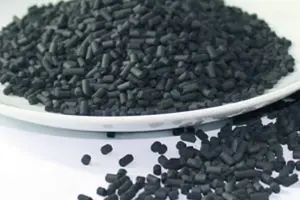
Surface impregnation involves chemically modifying activated carbon by applying a fine distribution of chemicals and metal particles onto its internal pore surfaces. This process significantly boosts the carbon’s adsorptive capacity by creating a synergistic effect between the chemicals and the carbon, offering a cost-effective method for removing impurities from gas streams that would be challenging to address otherwise.
Water treatment
Due to its antimicrobial and antiseptic properties, silver-impregnated carbon is highly effective for purification in domestic and other water systems on Earth.
Gas purification
Impregnated activated carbon is employed to treat flue gases in coal-fired power plants and various air pollution control applications. It can be specially impregnated to target the removal of acid gases, ammonia, amines, aldehydes, radioactive iodine, mercury, and inorganic gases such as arsine and phosphine. Metal-oxide-impregnated carbon is particularly effective for capturing inorganic gases including HCN, H₂S, phosphine, and arsine.








